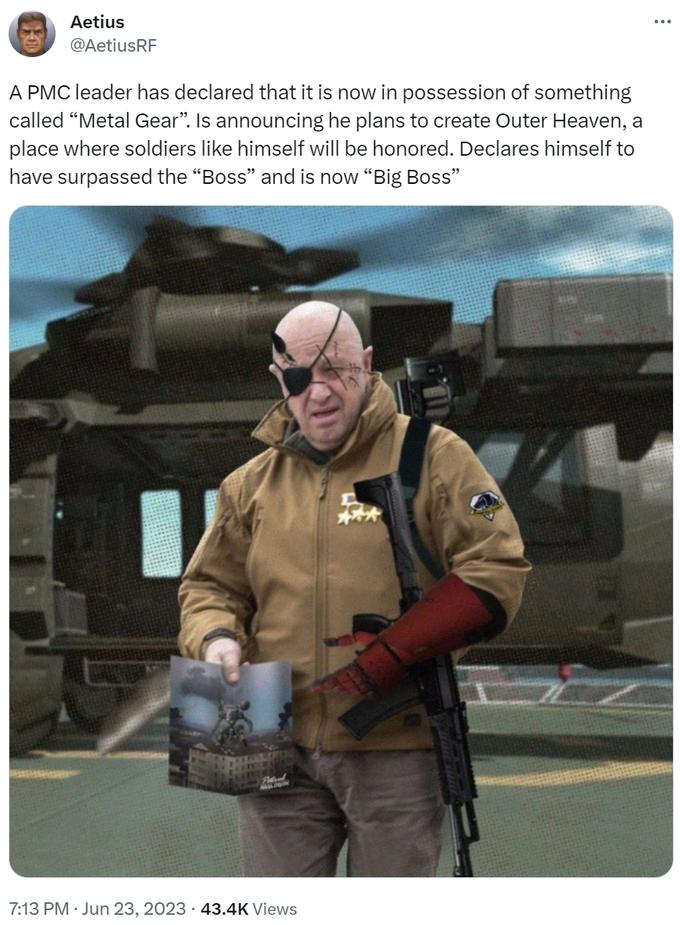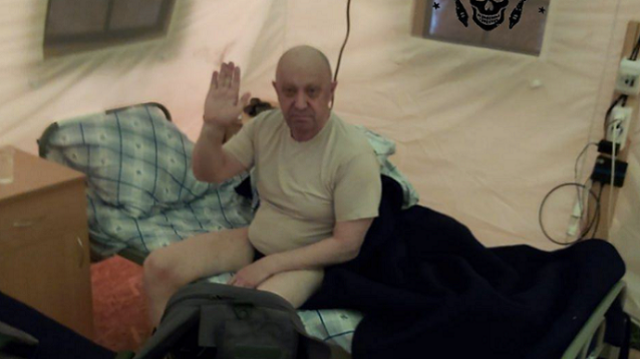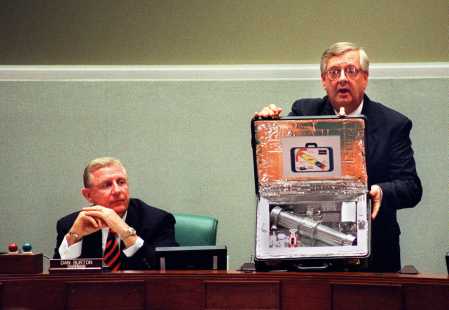Introduction: From Nuclear Terrorism to Nuclear Hybrid Threats (and Nuclear Hybrid Warfare)
The geopolitical threat posed by the charismatic leader of a private military corporation (PMC) in possession of a stolen nuclear weapon and set against the backdrop of conspiracy theories involving Russia are themes central to the narrative of Konami’s “Metal Gear” series of videogames.
From June 23-24 2023, Yevgeny Prigozhin, the ‘Big Boss’ of PMC Wagner led his troops in an unprecedented uprising against Vladimir Putin. This week, Ukrainian intelligence spread narratives that the Wagner mercenaries had attempted to steal “backpack nukes” from a military base in Russia during their march on Moscow [1]; and so it was that life imitated the art of Metal Gear.

Such scenarios as explored in Metal Gear and many other works of art might most often be classified academically under the keyphrase of “nuclear terrorism”. “Nuclear terrorism” (in quotes) seems a well-documented research area, which returned 22,300 hits today on Google Scholar for example.
However, for over a week before the narrative about Wagner raiding the nuclear base circulated, I had already been wondering if the Wagner uprising had been connected in any way to the tactical nuclear weapons which Russia had publicly placed in Belarus. I wondered if that may better explain Alexander Lukashenko’s strange role in the story as well.
In discussing my scenarios of using Wagner as a proxy for a deniable nuclear attack with hybrid warfare and disinformation expert Chris Kremidas-Courtney (Senior Fellow, Defense and Security, Friends of Europe), he told me I was describing a “nuclear hybrid threat”.
Kremidas-Courtney deserves credit for coining this term in an academic context from what I can tell based on a quick literature review. “Nuclear hybrid threat” does not occur on Google Scholar, and at least one of the two results for “nuclear hybrid warfare” appears to be a false positive.
Defining the PMC Wagner revolt more specifically in the scenario of a nuclear hybrid threat rather than as nuclear terrorism seems to have significant value from a modern academic information warfare perspective.
Hybrid threats have been defined by NATO as: “combin[ing] military and non-military as well as covert and overt means, including disinformation, cyber attacks, economic pressure, deployment of irregular armed groups and use of regular forces. Hybrid methods are used to blur the lines between war and peace, and attempt to sow doubt in the minds of target populations.” [2]
A nuclear hybrid threat could be defined as those nation-state hybrid threats which are related specifically to nuclear materials or weapons; and yet do not rise to the level of an actual nuclear war.
In this blog, I will seek to unpack the idea of 2023’s nuclear hybrid threats as generated by Russia in their war in Ukraine, especially as they relate to similar narratives of theoretical nuclear terrorism from Russia in the 1990’s involving “suitcase atomic bombs”, “briefcase nukes”, etc.
Perhaps this all ends up looking like a “nuclear cardboard box“…
Recapping the “Dominant” Narrative of the Rebellion
Amidst a 500-day thick fog of war in Ukraine nearly as confusing as the storylines of Metal Gear series creator Hideo Kojima, the “dominant” media narrative of the uprising seems to focus on the popular support which Prigozhin generated, and that an unlikely truce ending the crisis had been brokered by Vladimir Putin’s partner, Belarusian President Alexander Lukashenko.
This main narrative (at least in the West) also suggests that while Putin’s power was never seriously questioned, his reputation as the indisputable leader of Russia and his meticulously-crafted strongman image have been damaged – perhaps irreparably – by Prigozhin’s move.
There are still many questions about the circumstances which led to the end of Wagner’s revolt. These questions include the current official whereabouts and well-being of Prigozhin who does not seem to have returned to Belarus as negotiated by Lukashenko; with some US security officials going so far as to publicly state that Prigozhin may actually be dead or in prison (this is hardly a unanimous perspective).
The only picture to emerge of Prigozhin since the uprising originally was reported to have metadata suggesting it was taken on June 12, 2023, a date which was later changed to July 12, 2023 [3].

General Sergey Surovikin – who is reported to have close ties to Wagner – has also not been seen in public since the uprising, where he appeared on television without his epaulettes, leading to speculation he may have been detained. Wagner appears to be turning over their weapons and equipment to the Russian Ministry of Defense.
At this time, it does not seem clear that Prigozhin and Wagner’s reconciliation with Putin has necessarily been as amicable and forgiving as portrayed in the Kremlin communications specialists’ official accounts. In a recent interview, Putin (speaking like a lawyer) insisted that PMC Wagner “does not exist“.
Strategic Narratives of Russian Nuclear Hybrid Threats in 2023
On July 11, 2023, a new narrative emerged from the Ukrainian secret services leader Kyrylo Budanov. Budanov suggested that he possessed intelligence indicating that during the uprising, Wagner forces had approached a Russian nuclear base which had been used to store “backpack” style nuclear weapons. Budanov indicated that Wagner forces had not been successful in raiding the base [1].
On July 12, Kremlin spokesman Dmitry Peskov denied the Ukrainian reports classifying them as misinformation [4] or the “stuffing” of information warfare [5]. US officials also denied they saw any evidence that Wagner had attempted to acquire nuclear weapons from the Russian base [4].
Budanov’s story was very interesting to me, because I had been personally speculating for over a week on the idea that Wagner could have acquired one of the tactical nuclear weapons which Russia had recently publicly stated were placed in Belarus.
I felt that such a scenario of Wagner marching toward Moscow with a nuke would more likely explain the lack of opposition from the Russian military which Wagner had enjoyed during the uprising; as well as Lukashenko’s outsized role in brokering a solution to the problem.
However, there is another side to this theoretical coin which corresponds to counterintuitive narratives which speculate the coup had actually been staged by Russian security [6,7].
In such a scenario where Wagner had acquired tactical nuclear weapons under the guise of an armed uprising, that might provide the Kremlin plausible deniability to use such weapons on the battlefield without incurring a direct response from Western partners of Ukraine and NATO.
While it seems unlikely given his penchant for glasnost that Putin would willingly suffer such public reputational damage, perhaps the stakes are high enough in this case. In such a scenario, the West’s cognitive embrace of the man heretofore recognized as a psychopathic and ultranationalist warlord (Prigozhin) seems like something out of the reflexive control playbook. (We should not have sympathy for Prigozhin just because he is in public conflict with Putin. That is a cognitive security risk.)
Wagner’s long-standing modus operandi in Syria and Africa for example has been to provide such plausible deniability for the Kremlin.
Is the dominant narrative of the uprising an artifact of hybrid warfare in the cognitive domain leading to a discount of an actual clear and present nuclear threat posed by Russia?
I’m not going to claim to know any answers. The fog of falsehood is too thick in this time of war. I am just exploring scenarios which seem possible, and worth considering from a security perspective.
[Note: It seems pertinent to mention how the ongoing crisis at the Zaporizhia nuclear power plant in Ukraine is also shaping up as a more obvious “nuclear hybrid threat” to that of the Wagner uprising; with both strategic communications of Russia and Ukraine accusing the other party of planned sabotage at the plant which would effectively turn it into a massive “dirty bomb”.]
The “Briefcase Nuke” Threat Narrative of the 1990s
Kyrylo Budanov’s narrative of Wagner’s attempt to acquire “backpack nukes” during the 2023 uprising immediately calls to mind a common geopolitical concern from the mid-1990s involving “briefcase nukes” or “suitcase atomic bombs”. There was considerable worry that the disintegration of the Soviet Union could lead to a loss of control of these weapons and that they would fall into the hands of terrorist groups as a result.
The briefcase nuke story first heated up in the US in 1997, in relation to Russian politician, military General, and presidential aspirant Alexander Lebed, and Russian environmentalist Alexei Yablokov. Both men were close to the Yeltsin administration.
Additional pertinent details also were provided by high-ranking GRU defector Stanislav Lunev.
Despite the authority these men had in sustaining a narrative of briefcase nukes, none of them seem to have actually personally worked with the weapons; and their stories were not entirely consistent. A thorough analysis on the subject by the James Martin Center for Nonproliferation Studies also concluded that figures like Lebed and Yablokov may have had ulterior motives to spread these stories [8].
Alexei Yablokov’s narrative for example centered on the weapons being in the possession of the KGB [8,9]. In Yablokov’s story, he claimed to have met a man who had made such a weapon solely for terrorist uses on the orders of the KGB, and that the weapons were not entered into the official stockpiles of the Russian military. He was insistent on this point in his testimony to US House leaders [9].
However, Lebed and Lunev’s (unrelated) work seemed to point towards the Russian military being in charge of these weapons [8,10,11].
The 2002 analysis of the problem by the James Martin Center for Nonproliferation Studies also seemed to conclude that it was unlikely that such weapons would be under control of KGB and would instead be under the control of the 12th Main Directorate of the Ministry of Defense [8].
In his 1998 book, “Through the Eyes of the Enemy”, Stanislav Lunev said the devices had the designation: RA-115s, or RA-115-01s for the “submersible” variant of the weapon; and that they were in use by GRU Spetsnaz forces [10].
This corresponds with a weapons index number (RA-115) which General Igor Valynkin, then head of the 12th Main Directorate of the Ministry of Defense provided to Izvestia in October of 2001, following rumors that Chechens had provided Osama Bin Laden with up to 20 of these devices. Valynkin dismissed the persistent rumors he attributed to originating with Lebed’s 1997 efforts as “nonsense”, and claimed that all of the RA-115 munitions were accounted for but had been destroyed as part of joint nuclear threat reduction working with the United States [12].
Despite his comments in 2001 which seemed to confirm the existence of this class of weapon, Valynkin had denied that “nuclear suitcases” had ever existed in 1997. He also denied that any such device could be produced by the KGB or a successor agency (as claimed by Yablokov) [13].
Lunev had claimed in his book that “it is generally true that they can be fit into a briefcase, but they aren’t usually transported like that” and that “they weigh fifty to sixty pounds” [10, p.25]. Valynkin’s claim that “nuclear suitcases have never been produced and are not now being produced” in 1997 which seems to contradict a 2001 statement may therefore be seen as carefully chosen words, rather than an outright lie.

In his description of a use scenario for the device, Lunev alleged that such devices would have been hidden across the US in secret arms caches which Russian agents would use in the event of the outbreak of a major war to take out high value American targets (such as Air Force One landing sites) [10]. (No such caches have ever been found.)
Earlier narratives in the Russian press similar to those which Valynkin had denied also described Lithuania providing Chechens with “two 30kg “rucksack” nuclear devices” in 1991-1992, and another similar story about a Chechen bomb appeared in 1999 when Russia was seeking to begin the Second Chechen War [8].
The 2002 James Martin Center for Nonproliferation Studies report states unambiguously: “It should be noted, however, that Russian newspapers, which published stories about the sale of nuclear weapons to the Chechens, are among the least reliable sources of information in Russia, so their evidence should be taken with a grain of salt. Lebed himself stated that the story about the diversion of portable nuclear devices to Chechnya, which prompted his investigation in the first place, was eventually found to be false.” [8]
Arab press also carried a number of similar stories which may have pointed to Ukraine, Turkmenistan, and Kazakhstan as sources of sales of man-portable Russian nuclear devices to terrorist organizations; and none of these assertions were ever substantiated, either [8].
I personally found it interesting and perhaps concerning that former US Representative Curt Weldon R-PA, who led the committees which interviewed figures like Lebed, Yablokov, and Lunev in 1997-1998 had referred to Alexander Prokhanov’s “Zavtra” (a well known fascist and nationalist magazine) as a credible source of information during the hearings [9]. (Check out Weldon’s history of supporting our military here.)
It raises the serious question of whether the narratives about the briefcase nukes were almost entirely strategic disinformation, with the intent to disinform in a way which could support Russian strategy; or to otherwise cause general psychological panic. This is a very low cost weapon by that standard. A “nuclear cardboard box”.

The question of whether there is a confusion between “briefcase nukes” (eg. RA-115s) and nuclear mines has also been raised. Therefore, it should also be considered that various different classes of weapons may actually be intermingled in this discussion [8].
The nuclear mines would have been used by Russian engineering corps to mine the border with China primarily, as well as harbors; and it has been questioned if the concepts have become confused (especially by Yablokov, who claimed that there had been originally 700 suitcase nukes, which had been the same number of mines in the Russian nuclear stockpile, already withdrawn to storage facilities by 1997 for decommissioning) [8].
Accounts of the nuclear mines indicate their weight was approximately 90kg (~200lb) [8], which is certainly less portable than the 50-60 pounds (~25kg) described by Lunev in the case of the RA-115s designated weapon.
Lebed and Lunev’s discussion of the RA-115s weapon seems to accord with the idea of it being used by Russian GRU Spetsnaz forces; and this seems to be at least partially corroborated by Valynkin.
In statements to the US House of Representatives Committee on National Security on August 4, 1998; Lunev discussed nuclear terrorism, and told the committee that if terrorists did manage to detonate such a device in America or elsewhere, it could only have been with the help of Russian secret services [11].
Fortunately, it seems consistent in the descriptions of these devices that they require a significant amount of maintenance. Some accounts describing a bi-annual maintenance cycle, or the requirement for a continuous power supply to maintain the device. These factors seem to indicate that many of these weapons would have significantly degraded over time without the required maintenance, potentially not even being operable.
However, it does lend credence to the idea that specialized expertise and maintenance would be necessary to keep these weapons viable, and perhaps that supports Lunev and Yablokov’s assertions that if these weapons had been used in a terroristic context, there would logically be a strategic Russian interest behind it. They’re just too hard to maintain by non-nation state specialists without access to the parts and know-how.
Therefore, had a terrorist organization which was found to be a proxy of Russia used such a weapon – even in the 1990s – in retrospect, it might have actually been a “nuclear hybrid threat” problem rather than a “nuclear terrorism” problem.
Conclusion
In researching the narrative of “backpack nukes” in relation to Wagner in 2023, we can see some parallels with the “briefcase nukes” story from the 1990’s.
The 1990’s stories frequently occurred in the context of potentially disinformative Russian media narratives about groups in breakaway republics like Chechnya acquiring these weapons. They may have had a strategic disinformation dimension which sought to justify military action, or otherwise win allies to Russia’s side.
Regardless of whether the RA-115s or a similar (perhaps more modern) Russian weapon exists, it is a threat we must take seriously. It is well known that US forces employed similar weapons and tactics during the Cold War. Figures like Lebed were unable to find evidence that Chechens or others had acquired these weapons, despite finding potential discrepancies in the accounting of the weapons.
Without any evidence however other than the testimony of potentially motivated persons to spread these stories about Russian man portable weapons falling into the wrong hands; the real power of Russian suitcase atomic bombs and backpack nukes to date lies in their ability to keep us up at night. To imagine that the person next to you on the commuter train has a nuclear bomb in that innocent-looking briefcase. There is a powerful cognitive dimension to this problem.
The stories described by figures like Lunev and Yablokov strongly suggested that these weapons may be used by Russian proxies in a terroristic context. In this sense, we could perhaps consider the briefcase nuke concern of the 1990s in the context of not only disinformation and cognitive warfare, but representing a potentially legitimate nuclear hybrid threat as well.
It seems like all options are on the table in this historical rhyme which seeks to add the concept of nuclear hybrid threats to the nuclear terrorism discussion in June and July 2023.
The face value of the PMC Wagner rebellion does not give me confidence that Prigozhin’s mercenaries do not remain a greater threat to the West than they do to Putin’s regime. This may all be part of the same parcel of nuclear hybrid threats playing out at the Zaporizhia plant.
References:
[1] Mari Saito et al., “Wagner fighters neared Russian nuclear base during revolt“, Reuters, July 11 2023, https://www.reuters.com/world/europe/wagner-fighters-neared-russian-nuclear-base-during-revolt-2023-07-10/
[2] NATO Topic: Countering Hybrid Threats, Last Updated July 6 2023, https://www.nato.int/cps/en/natohq/topics_156338.htm
[3] Tetiana Lozovenko, “Photo of Wagner Chief in underwear in Wagner Group camp may be real – media“, Ukrainian Pravda, July 14 2023, https://www.pravda.com.ua/eng/news/2023/07/14/7411338/
[4] Guy Faulconbridge, “Kremlin dismisses Ukraine’s assertion on Wagner seeking nuclear devices“, Reuters, July 12 2023, https://www.reuters.com/world/europe/kremlin-dismisses-assertion-that-wagner-intended-acquire-nuclear-devices-2023-07-12/
[5] Sergey Averyanov, «Кремль опроверг информацию о наличии у ЧВК «Вагнер» ядерного оружия» (“The Kremlin denied information about the presence of PMC “Wagner” nuclear weapons“), July 13 2023, Politlogic, https://politlogic.ru/kremlin-has-denied-information-about-presence-nuclear-weapons-wagner-pmcs/
[6] Melik Kaylan, “The Wagner Mutiny: Was It Genuine Or Choreographed? And What Now? “June 25 2023, Forbes https://www.forbes.com/sites/melikkaylan/2023/06/25/the-wagner-mutiny-was-it-genuine-or-choreographed-and-what-now/
[7] Rebekah Koffler, “The Wagner ‘Coup’ Was Staged by Putin—and the West Fell for It. Opinion“, June 29 2023, Newsweek, https://www.newsweek.com/wagner-coup-was-staged-putin-west-fell-it-opinion-1810035
[8] James Martin Center for Nonproliferation Studies, “Suitcase Nukes:” A Reassessment”, September 23 2002, https://nonproliferation.org/suitcase-nukes-a-reassessment/
(see also:) Nikolai Sokov, “Suitcase Nukes: “Permanently Lost Luggage“”, James Martin Center for Nonproliferation Studies, February 13 2004, https://nonproliferation.org/suitcase-nukes-permanently-lost-luggage/
[9] Atomic Suitcase Bombs, October 2 1997, Frontline (PBS), https://www.pbs.org/wgbh/pages/frontline/shows/russia/suitcase/yablokov.html
(see also:) Comments on Russia’s Atomic Suitcase Bombs, Frontline (PBS), https://www.pbs.org/wgbh/pages/frontline/shows/russia/suitcase/comments.html
(see also:) https://www.pbs.org/wgbh/pages/frontline/shows/russia/suitcase/index.html
[10] Stanislav Lunev with Ira Winkler, Through the Eyes of the Enemy, Regnery Publishing, Inc., Washington DC, 1998
[11] US House Hearing on United States/Russian National Security Issues, August 4 1998, Committee on National Security, Military Research and Development Subcommittee, https://web.archive.org/web/20230208225537/http://commdocs.house.gov/committees/security/has216010.000/has216010_1.HTM
[12] Dmitry Safonov, «Индивидуальная планировка» (“Individual Planning”), Izvestia, October 26 2001, https://iz.ru/news/253943
[13] Deseret News, “Moscow denies ever producing `nuclear suitcases’“, September 24 1997, Deseret News (Reuters News Service), https://www.deseret.com/1997/9/25/19336148/moscow-denies-ever-producing-nuclear-suitcases
Postscript: Alexander Lebed
Alexander Lebed seems a very interesting figure in retrospect in 2023. Reputation generally seems good to me. I’ll mention briefly here some interesting asides separate from the briefcase nukes matter:
A.) Lebed was notable for his personal meeting with Donald Trump in New York 1997 where they apparently discussed real estate projects in Russia. Lebed humorously demanded that no skyscraper could be so tall as otherwise someone would “spit on the Kremlin”. [https://www.nytimes.com/1997/01/23/world/unlikely-meeting-of-minds-lebed-meets-the-donald.html]
B.) Lebed seems to have been notable for accusing the Russian government of orchestrating the 1999 Moscow bombings as a cynical plot to prevent elections. This caused then Prime Minister Vladimir Putin to criticize him. Lebed seemed to focus on the corruption of the Yeltsin administration in his accusation rather than directly foreshadowing a conflict with Putin himself [https://lenta.ru/news/1999/09/29/lebed/].
C.) As Governor of Krasnoyarsk, Lebed died in April 2002 following a helicopter crash and Putin publicly investigated it. Some narratives have alleged the helicopter was sabotaged, and Lebed murdered [https://antikor.com.ua/ru/articles/39010-aleksandra_lebedja_ubili_po_prikazu_putina._rassledovanie].
